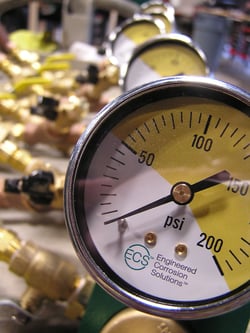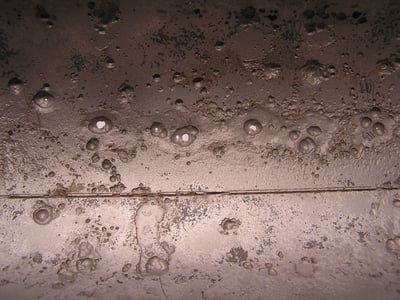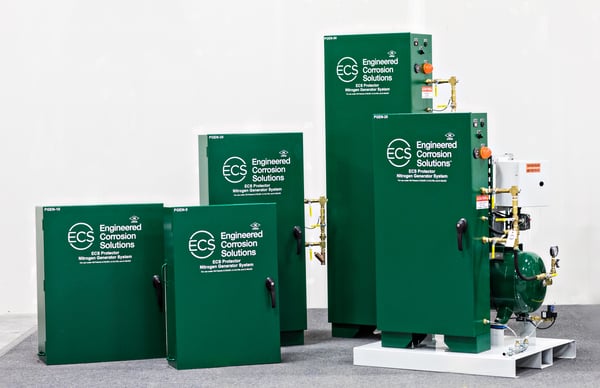ECS’ fire protection engineer, Lucas Kirn, was a recent guest on the "Fire Sprinkler Podcast" hosted by Chris Logan, a third-generation sprinkler fitter-turned designer who proclaims that he “bleeds sprinkler water."
This episode of the podcast touches on the past, present and future of the fire sprinkler industry; corrosion myths; how and why corrosion happens, and what to do about it when it does. Find out more about Chris and his passion for all things sprinkler industry at Firesprinklerpodcast.com.
Here are some of the top highlights from the podcast.
1. Corrosion Myths
Chris Logan: “What are some of the issues and what are some of the things that people think happened? What are the myths associated with corrosion?”
Lucas Kirn: “Sure. Probably the biggest one out there is that almost everybody in the industry has heard the term MIC, which stands for microbiologically influenced corrosion. It implies that bacteria are either directly eating away at the pipe wall until it fails or creates a pinhole leak, or producing some sort of byproduct like an acid that is eating away at the pipe. Our CEO has a background in corrosion in the oil and gas industry, and he had a ton of experience with MIC, he came into the industry thinking what at the time was the most prevalent thought process behind corrosion: that it's all related to MIC.
He started to look at it and it only took him 30 or 60 days looking at all these issues that were coming up, and he's like, this isn't MIC, this isn't what I'm used to seeing when I was studying MIC, this is all just oxygen corrosion. So really what we found is that while a MIC is a real thing that can occur in fire protection systems, it is almost always a secondary factor [to oxygen corrosion].”
For more information on industry myths, see our two white papers below:
Industry Myths Regarding Corrosion in Fire Sprinkler Systems
MIC is NOT the Primary Cause of Corrosion in Fire Sprinkler Systems
2. Nitrogen Inerting of Wet Pipe Fire Sprinkler Systems
 Chris Logan: “So you mentioned the venting of wet pipe systems. Let's talk a little bit about that. I know ECS just had an air relief valve listed and approved for NFPA 13 for use in wet pipe sprinklers systems. What is the purpose of that and why did NFPA 13 in 2016 require air venting on wet sprinkler systems?”
Chris Logan: “So you mentioned the venting of wet pipe systems. Let's talk a little bit about that. I know ECS just had an air relief valve listed and approved for NFPA 13 for use in wet pipe sprinklers systems. What is the purpose of that and why did NFPA 13 in 2016 require air venting on wet sprinkler systems?”
Lucas Kirn: “Not to try and get really down and dirty with the science, but when a system is empty, it's sitting at atmospheric pressure but is filled with air, which is 21 percent oxygen. As soon as you start flowing water into that system that air doesn't have anywhere to go, it just gets compressed into the remote ends and the high points of the system.
So now you have these trapped pockets of gas in the system and nowhere for it to go. And what happens is that the oxygen will react with the metal; it will cause corrosion until all the oxygen in the system has been consumed. The ECS automatic air vent is the most basic and cost-effective approach that we developed. The correlation between oxygen removal and corrosion activity is directly proportional. If you get rid of 50 percent of the trapped air in a system, you're going to reduce the corrosion activity in that system by 50 percent.”
3. Testing – ECS Pipe Analysis
Chris Logan: “Let's get into a little bit of the testing. How do you test to determine if you have corrosion in your system?”
Lucas Kirn: “We really believe that the best starting point for corrosion testing is taking a pipe sample from the system. If you have a section of pipe that you've had to remove because it had a failure, that's a great place to start. Or we can direct our customers to look at specific areas of a system and take a sample. Just cut out a section of pipe and we process it.
Believe it or not, just from looking at the types of metal loss and the types of pits that are forming we can determine whether it's an oxygen corrosion pit, bacterial corrosion (MIC), or whether it's something unusual like an acid type of corrosion. Physically examining the pipe that was in the system is the best method to determine what type of corrosion you have and how severe it is."
4. Galvanized Piping – Does it Fail Faster than Black Steel Piping?
 Chris Logan: "It was a big shock to me when I started digging into nitrogen in corrosion solutions. Galvanized pipe, contrary to popular belief, is actually one of the worst pipes you can put in a sprinkler system."
Chris Logan: "It was a big shock to me when I started digging into nitrogen in corrosion solutions. Galvanized pipe, contrary to popular belief, is actually one of the worst pipes you can put in a sprinkler system."
Lucas Kirn: ”Galvanized material is great at preventing atmospheric corrosion, external corrosion. We see it on guard rails and fence posts and flag poles and they use it in a fire alarm and electrical conduit. But what we found was that in fire sprinkler systems it just wasn't holding up, contrary to popular belief. We found that galvanized pipe, while it doesn't produce as much corrosion byproduct and debris, will form a pinhole leak much faster through the pipe wall. We have seen a brand-new schedule 10 galvanized system fail in as little as 12 months. This was at a US Airport undergoing major renovations.
I'd recommend (for people who were further interested in the topic) the FM Global Data Sheet 2-1, which specifically discusses corrosion and fire sprinkler systems."
5. ECS Nitrogen Generators for Dry and Wet Pipe Fire Sprinkler Systems
Chris Logan: “The system is going to fail one way or another. Right. So what products do you guys have? What does Engineered Corrosion Solutions have out there to help mitigate corrosion in dry sprinkler systems right now?”
 Lucas Kirn: “We sell a whole line of nitrogen generators. We have seven different sizes. We have three different models that are wall-mount units. They've been a very popular seller for us since we first introduced them, because they literally don't take up any floor space.
Lucas Kirn: “We sell a whole line of nitrogen generators. We have seven different sizes. We have three different models that are wall-mount units. They've been a very popular seller for us since we first introduced them, because they literally don't take up any floor space.
These wall-mount models are great. They're only about nine inches deep. They look like just like an electrical cabinet hanging from the wall and tie right into the fire sprinkler system. Then we have larger capacity, standalone systems, and those are going to be designed to provide plant nitrogen for larger facilities.”
We developed a method for wet pipe nitrogen inerting. It’s the same concept [as for dry systems] in that we're trying to remove the oxygen gas from the system and replace it with nitrogen, but the application or the treatment processes differently. It's become very popular for remediation of existing systems where people have an existing wet pipe system and they know they have an issue with continuously replacing pipe. They're looking for a solution. And we found that this is very successful as long as the system is maintained properly. The corrosion is essentially stopped dead in its tracks and no longer continues as soon as you remove the oxygen.”
6. The Future of Corrosion Management in Fire Sprinkler Systems
Chris Logan: “What do you think, where is the future of corrosion management going?"
Lucas Kirn: "What we've already started to see is code and standard changes that have started to occur. You mentioned the NFPA 13 requirement in 2016 for an air vent on wet systems. I mentioned the factory mutual data sheet that was updated and strongly recommends the use of nitrogen in dry and preaction [systems] and the use of air vents on wet systems. For work on government projects in the United States, there is a code called the UFC, the Unified Facilities Criteria; basically the Military and Department of Defense use it as their standard, requiring nitrogen on all dry and preaction systems in federal civilian government facilities.
Everything is pointing in the direction of greater adoption and widespread usage of corrosion management systems.
Everything is trending, even on the residential side, where smart buildings and smart homes and everything else communicates together and I think that's long term. I think that's going to be what we see with fire protection systems, fire alarm systems, fire systems maintenance and parts, building management systems, and corrosion management systems. They are all going to communicate, form a more efficient system and provide a lot more information to the building owner or property manager so they can catch [issues] before they become problematic."
Chris Logan: “The industry is evolving very fast and if I’ve said it once, I've said it a hundred times: if you're not willing to evolve with the industry, the industry is going to evolve and move on without you.”






